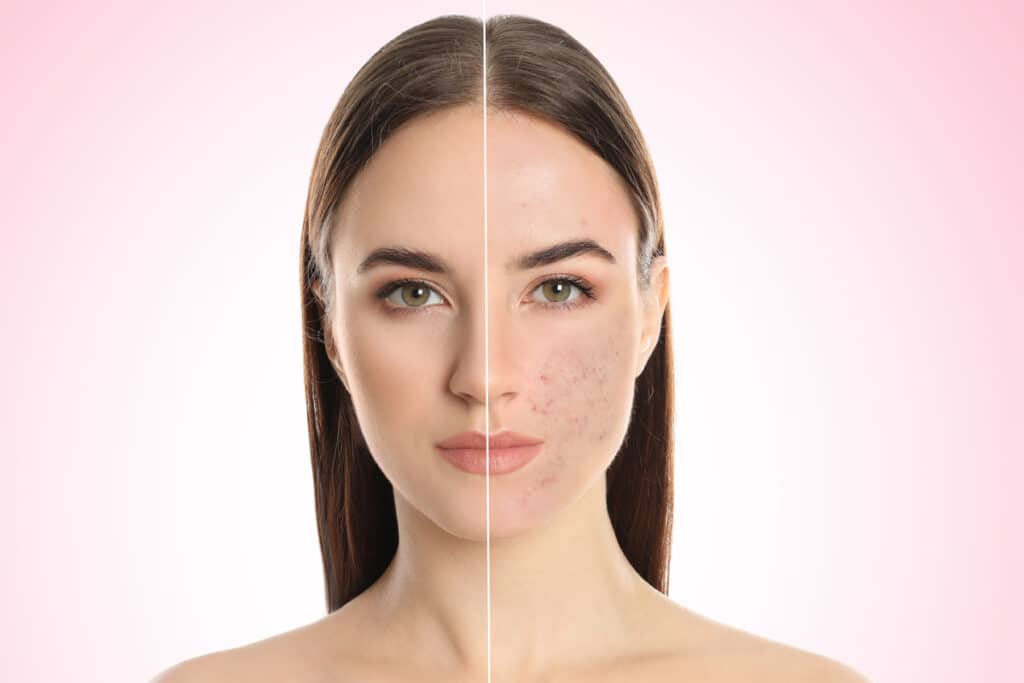Acne scars can be a source of discomfort and self-consciousness for many individuals. While there are numerous treatments available to address acne scarring, one question that often arises is whether a facelift procedure can help improve the appearance of these scars.
Facelifts can reduce acne scars and give you smoother, younger-looking skin. They might be effective for improving mild facial scars from acne.

Improving Acne Scars with Facelifts
- Facelifts can help improve the appearance of mild acne scars by tightening and repositioning the skin, though they are primarily designed to address aging signs.
- Acne scars form due to clogged pores and inflammation, leading to different scar types such as ice pick, boxcar, rolling, and keloid scars.
- Factors contributing to acne scarring include hormonal imbalances, genetics, poor skincare habits, and severe acne outbreaks.
- Effective treatments for acne scars besides facelifts include laser skin resurfacing, chemical peels for acne scars, dermal fillers, and microneedling.
- Considering a facelift for acne scars involves understanding potential risks like infection, bleeding, new scarring, anesthesia complications, high costs, and extended recovery time.
What are Acne Scars?
Acne scars happen when your skin’s pores get clogged with oil, dead skin cells, and bacteria, leading to inflamed blemishes. When a pore swells up and breaks the follicle wall, a scar can form. These scars can be raised or sunken, and they range from mild to severe.
There are different types of acne scars:
- Ice pick scars: Deep and narrow
- Boxcar scars: More defined with sharp edges
- Rolling scars: Create a wavy texture on the skin
- Keloid scars: Raised, thick, and reddish-purple
The type of scar you have can affect how well different treatments work. That’s why it’s important to talk to a dermatologist or medical professional to figure out the best treatment for your specific scars.
Causes of Acne Scarring
Acne scars can result from a few several factors:
Hormonal Imbalances
Your body may create more oil as your hormones change, which would cause acne and finally scarring.
Genetics
Some people’s genes just make them more likely to get acne scars. It influences their skin’s healing process and handling of inflammation.
Poor Skin Care Habits
Scarring can result from improper skin cleansing, severe product use, or picking at your acne.
Severe Acne Outbreaks
You are more likely to get scars if your severe acne features deep, inflammatory lesions.
Types of Acne Scars
Several types of acne scars can develop, each with its unique appearance and characteristics. Some common types of acne scars include:
Atrophic Scarring (Boxcar)
Collagen loss in healing causes these sunken or depressed scars. A type of atrophic scar, boxcar scars have sharp edges and a broad, shallow base.
Superficial Scarring
From milder acne, these are shallow, indented scars. Usually less conspicuous, they can be treated without surgery most of the time.
Deep Acne Scarring (Icepick)
Deep and thin, ice-pick scars reach the dermis and give the skin pits. They are harder to repair than other scars and result from extreme acne.
Struggling with Signs of Facial Aging?
Experience world-class treatment from our top-rated providers at Becker Plastic Surgery.
The Facelift Procedure
The goal of a facelift is to reduce visible signs of aging on your face and neck. During surgery, the surgeon tightens the tissues and muscles beneath your skin, removes any extra skin, and repositions it to give you a smoother, younger look. It can help with sagging skin, deep facial lines, and loose skin on the neck. But keep in mind, that facelifts mainly target aging signs, not acne scars.
Even though a facelift isn’t specifically meant to tackle acne scars, it might help improve the look of mild ones. When your skin is tightened and repositioned, it can smooth out the surface a bit, making shallow scars less visible. However, don’t expect dramatic changes for severe acne scars.

What Facelifts Can and Cannot do for Acne Scars
Facelifts can make mild acne scars look better by removing loose skin and tightening what’s left, which can smooth out your skin and make superficial scars less noticeable. However, they aren’t designed to fix acne scars specifically, and they won’t do much for deeper scars like ice pick or boxcar scars.
It’s important to have realistic expectations if you’re thinking about a facelift to help with acne scars. While it might offer some improvement, it won’t completely get rid of deep scars. For those, other treatments might be more effective.
Other Treatments For Acne Scars
According to your specific needs, you can choose different treatments for acne scars:
- Laser Skin Resurfacing: This non-surgical treatment uses a laser to remove the outer layers of skin, helping new skin cells to grow. This helps to reduce shallow acne scars and improve your skin’s texture.
- Chemical Peels: A chemical solution is applied to your skin, causing it to exfoliate and peel off, revealing fresh skin underneath. This can improve the look of surface-level acne scars and even out your skin tone.
- Dermal Fillers: These are injections that fill in depressed acne scars, giving your skin a smoother, more even appearance. Fillers are not permanent, so you might need to get them redone to keep the results.
- Microneedling: This procedure uses a device with fine needles to create tiny punctures in your skin. This boosts collagen production, which can help improve the look of acne scars and enhance your overall skin texture.
Make sure to talk to a qualified professional to figure out which treatment is best for your acne scars.
Risks and Considerations of Facelifts for Acne Scars
Thinking about getting a facelift to help with acne scars? It’s important to know about the risks and considerations involved. Here are some key points:
- Potential Risks:
- Infection: Like any surgery, there’s a chance of getting an infection.
- Bleeding: Some bleeding is normal, but excessive bleeding can be a problem.
- Scarring: While the goal is to reduce scars, there’s a risk of new ones forming.
- Anesthesia Complications: Anesthesia can sometimes cause issues, although it’s generally safe.
- Cost and Recovery:
- Expense: Facelifts can be pricey, and insurance usually doesn’t cover cosmetic procedures.
- Recovery Time: You might need several weeks to recover, which could mean taking time off work and avoiding heavy activities.
It’s really important to talk about all these factors with your surgeon before making a decision.
Schedule an Appointment with a Facelift Surgeon
If you are considering facelift surgery to improve the appearance of your acne scars, it is essential to schedule a consultation with one of our qualified and experienced facelift plastic surgeons at Becker Plastic Surgery.
During your appointment, your surgeon will evaluate your skin, discuss your concerns, and determine if a facelift is the most appropriate treatment option for you. They may also recommend alternative treatments that may be more suitable for your specific acne scar concerns. Let our highly skilled and professional facelift surgeons guide you through the process.
Schedule a consultation today to discuss the most suitable treatment options for your acne scars and start your journey toward a rejuvenated appearance. Click here to book your appointment with our experts now.